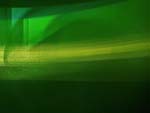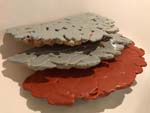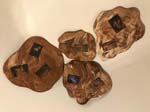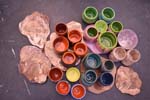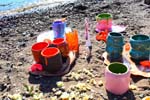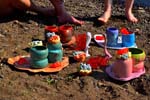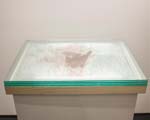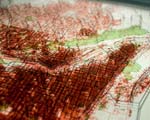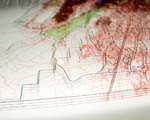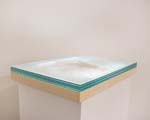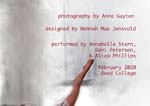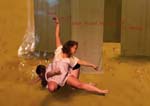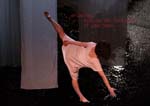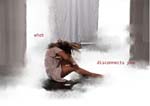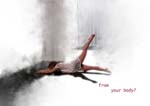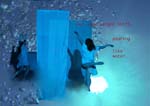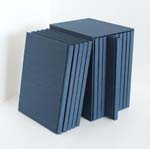2020 Senior Theses
2020 Virtual Thesis Show
Instructions for MacOS
Instructions for Windows
Ezra Bergmann
Reverie Machines
This thesis examines the effect moving images and the screen has on its spectator. There is a connection between moving image apparatuses and dream-like states. In a sense these apparatuses create artificial dreams experiences for the spectator. However, noting the Freudian theory of dreams being a source of wish fulfillment and the fabricated quality of moving images, this thesis approaches the question “Should we be threatened by the moving image?” The second chapter argues that the computer interface should be considered as a cinematic medium, and that it has the same effect on its users as the cinema does on its spectator. This fact makes our current circumstances even more troublesome, as personal computing devices have become engrained in day-to-day life, and our lives are increasingly mediated by the computer interface.
Sophia Farmer
coral: eat a great amount and very well
My Studio Art Thesis examines the body’s relationship to the ocean through coral reefs, queer intimacy and landscaping. It focuses on Ahmed’s use of queer Phenomenology to understand the body’s orientation towards coral reefs and seeks to re-imagine the confines of emotional responses to human bodies. The thesis begins with a specific phenomena in which a Barrier Reef in New Caledonia began fluorescing as a way to survive rising water temperatures.
The accompanying work employs camp aesthetics and what John Paul Ricco names “the queer feeling of neutral-mourning” to create a moment of indulgence and intimacy with the ocean and oneself through the heightened sensations of the ocean. I created a series of ceramics, candles, hard candy and cupcakes which became realized through the documentation of photographs, a virtual gallery space and performance.
Zoom link: https://zoom.us/j/98732793409
Steven Garcia
In Consideration of Ethical Grounds
This document surveys scientific literature on soil quality and health, as well as providing an exploration of artists, ecologists and landscape architects working to redefine the way humans interact with the earth, while simultaneously informing the public in an attempt to reimagine the future of land use and stewardship. Through a collection of soil samples collected around the Portland metro area, biological, chemical and physical properties were analyzed to determine how soil health differs across the city. A series of maps produced with ArcGIS were then used to overlay urbanization and social economic gradients over soil data to demonstrate what areas of the city and socioeconomic groups have greater access to healthy soil.
Due to the issued state of emergency in Oregon due to COVID-19, all lab work and studio work have been suspended.
Zoom link: https://zoom.us/j/98496720514
Hannah Mae Jensvold
Inhabit
Embodiment is the central experience of occupying a body and can be affected, altered, and heightened by the perception, through the senses, of various outside phenomena. This thesis seeks to understand the mechanisms of embodiment and its relationship to representations and uses of the body in visual art and contemporary dance through theory and the examination of works which engage with the body and its traces. A part of this research was also the development of a choreographic work about connection to and disconnection from the body, which also made use of handmade costumes, large set pieces, and video projection to create a space to explore particular phenomena and their effect on embodiment. An installation that would allow viewers to enter a similar space and have their own embodied experience and affect the space with their own bodies was planned, but due to changing circumstances related to the COVID- 19 crisis, a virtual exhibition was designed instead. The virtual installation sought to provide users a similar experience, but also allowed them to enter inside of phenomena to a surreal effect that would not have been possible in a physical installation.
Duncan King
Marine Parade and Other Photobooks about Family
Photography books are a wide-ranging genre, from a book of Ansel Adams’ most beautiful images to Ed Ruscha’s catalogues of buildings in Los Angeles. While all of these books are wonderful, there is a subgenre within “photography books” that is a powerful medium for all kinds of subjects. “Photobooks,” as I term them, are a sort of artist’s book devoted to communicating ideas and feelings through predominantly photographs. The photobook deserves to be referred to as a genre of its own precisely because it is such an effecting, accessible, and relatable medium, adaptable for a huge number of subjects.
Family is one such subject that the photobook is perfect for. By emulating family photo albums, naturally producing narrative, and implying intimacy through their material qualities, photobooks are one of the best ways an artist can go about telling a story involving their families.
This thesis focuses on the photobook to make a case for the art form as a powerful medium, especially when it comes to family. I start my analysis of other artists’ works with examples of photobooks that do and do not involve families in order to show the flexibility of the medium, before I go in depth into works about families and how they tell their respective stories. I also analyze the work I produced, which includes three small booklets and a more finished, hand-bound photobook titled Marine Parade.


